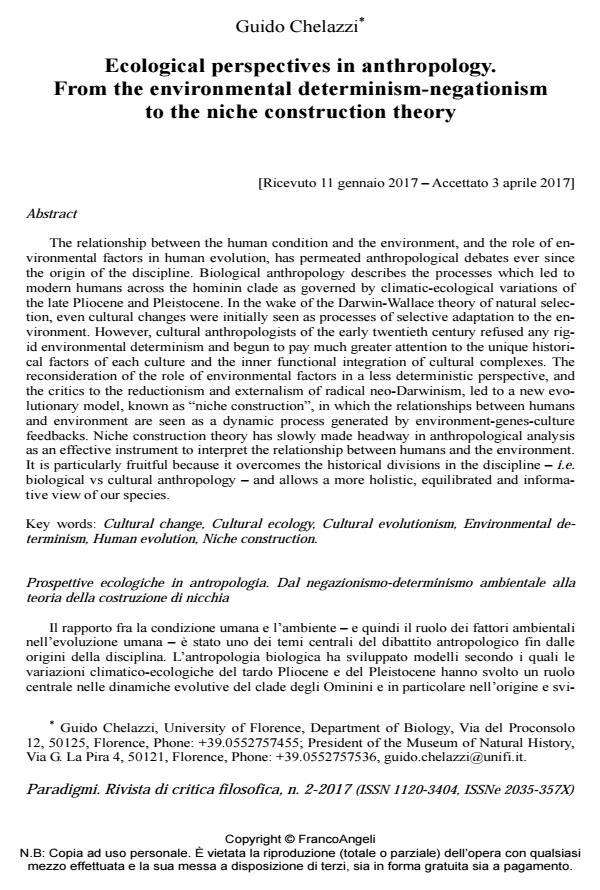Ecological perspectives in anthropology. From the environmental determinism-negationism to the niche construction theory
Titolo Rivista PARADIGMI
Autori/Curatori Guido Chelazzi
Anno di pubblicazione 2017 Fascicolo 2017/2
Lingua Inglese Numero pagine 17 P. 123-139 Dimensione file 187 KB
DOI 10.3280/PARA2017-002009
Il DOI è il codice a barre della proprietà intellettuale: per saperne di più
clicca qui
Qui sotto puoi vedere in anteprima la prima pagina di questo articolo.
Se questo articolo ti interessa, lo puoi acquistare (e scaricare in formato pdf) seguendo le facili indicazioni per acquistare il download credit. Acquista Download Credits per scaricare questo Articolo in formato PDF

FrancoAngeli è membro della Publishers International Linking Association, Inc (PILA)associazione indipendente e non profit per facilitare (attraverso i servizi tecnologici implementati da CrossRef.org) l’accesso degli studiosi ai contenuti digitali nelle pubblicazioni professionali e scientifiche
The relationship between the human condition and the environment, and the role of environmental factors in human evolution, has permeated anthropological debates ever since the origin of the discipline. Biological anthropology describes the processes which led to modern humans across the hominin clade as governed by climatic-ecological variations of the late Pliocene and Pleistocene. In the wake of the Darwin-Wallace theory of natural selection, even cultural changes were initially seen as processes of selective adaptation to the environment. However, cultural anthropologists of the early twentieth century refused any rigid environmental determinism and begun to pay much greater attention to the unique historical factors of each culture and the inner functional integration of cultural complexes. The reconsideration of the role of environmental factors in a less deterministic perspective, and the critics to the reductionism and externalism of radical neo-Darwinism, led to a new evolutionary model, known as "niche construction", in which the relationships between humans and environment are seen as a dynamic process generated by environment-genes-culture feedbacks. Niche construction theory has slowly made headway in anthropological analysis as an effective instrument to interpret the relationship between humans and the environment. It is particularly fruitful because it overcomes the historical divisions in the discipline - i.e. biological vs cultural anthropology ? and allows a more holistic, equilibrated and informative view of our species.�
Il rapporto fra la condizione umana e l’ambiente ‒ e quindi il ruolo dei fattori ambientali nell’evoluzione umana ‒ è stato uno dei temi centrali del dibattito antropologico fin dalle origini della disciplina. L’antropologia biologica ha sviluppato modelli secondo i quali le variazioni climatico-ecologiche del tardo Pliocene e del Pleistocene hanno svolto un ruolo centrale nelle dinamiche evolutive del clade degli Ominini e in particolare nell’origine e svi-luppo del genere Homo. Sull’onda del successo della teoria dell’evoluzione per selezione naturale di Darwin-Wallace, si è presto sviluppata una corrente di pensiero che considerava anche i cambiamenti culturali come processi evolutivi generati dalla selezione ambientale. Il Darwinismo è stato però generalmente rifiutato dall’antropologia culturale e dall’etnografia del XX secolo, che si sono orientate verso l’analisi dei fattori storici intrinseci e delle coerenze funzionali interne alle varie culture umane. La rivalutazione in chiave meno deterministica dei fattori ecologici nel cambiamento culturale e la critica del riduzionismo ed esternalismo del neo-Darwinismo più radicale hanno prodotto nuovi modelli evolutivi nei quali ambiente, genetica e cultura sono visti come fattori interattivi di un processo dinamico chiamato "costruzione di nicchia". La teoria della costruzione di nicchia si è fatta recentemente strada nel dibattito antropologico per la sua capacità di reinterpretare i processi evolutivi in una prospettiva più olistica e di ricomporre alcune profonde divergenze fra antropologia biologica e culturale.
Parole chiave:Cambiamento culturale, Costruzione di nicchia, Determinismo ambientale, Ecologia culturale, Evoluzione umana, Evoluzionismo culturale.
Guido Chelazzi, Ecological perspectives in anthropology. From the environmental determinism-negationism to the niche construction theory in "PARADIGMI" 2/2017, pp 123-139, DOI: 10.3280/PARA2017-002009